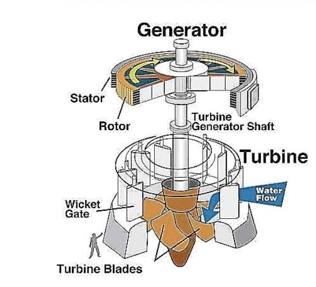Keras LSTM¶
import pandas as pd
import matplotlib.pyplot as plt
import seaborn as sns
from pandas.plotting import register_matplotlib_converters
# plt.style.use(['science','no-latex'])
# plt.rcParams["font.family"] = "Times New Roman"
%load_ext autoreload
%autoreload 2
import tensorflow as tf
The autoreload extension is already loaded. To reload it, use:
%reload_ext autoreload
1, Load the data¶
from tensorflow import keras
#from google.colab import drive
#drive.mount('/content/drive')
#df = pd.read_csv('/content/drive/MyDrive/Data/vattenfall_turbine.csv')
#drive.flush_and_unmount()
#print('NB: Unmount the google cloud driver')
#import numpy as np
#
##df = pd.read_csv('vattenfall_turbine.csv')
#keys = df.keys().values
#feature_keys = keys[np.arange(1,5).tolist() + np.arange(7,10).tolist()]
#time_key = keys[0]
################# IN case not by Colab #########
import numpy as np
df = pd.read_csv(r'E:\FEM\Python\bitbucket\Vattenfall_rnn\vattenfall_turbine.csv')
keys = df.keys().values
feature_keys = keys[np.arange(1,5).tolist() + np.arange(7,10).tolist()]
time_key = keys[0]
plot_cols = feature_keys[0:len(feature_keys):2]
plot_features = df[plot_cols]
#plot_features.index = df[time_key]
fig1 = plot_features.plot(subplots=True, figsize=(10, 8))
plt.show()
from IPython.display import display, Markdown
#display(Markdown(' <font size="6"><span style="color:blue">**Lets take a close look at the time series.**</span> </font>'))
display(Markdown('<span style="color:blue;font-size:50px">**Lets take a close look at the time series.**</span>'))
plot_features = df[plot_cols][int(len(df)/5):int(len(df)*4/5):10]
#plot_features.index = df[time_key][:480]
fig2 = plot_features.plot(subplots=True, figsize=(15, 10))
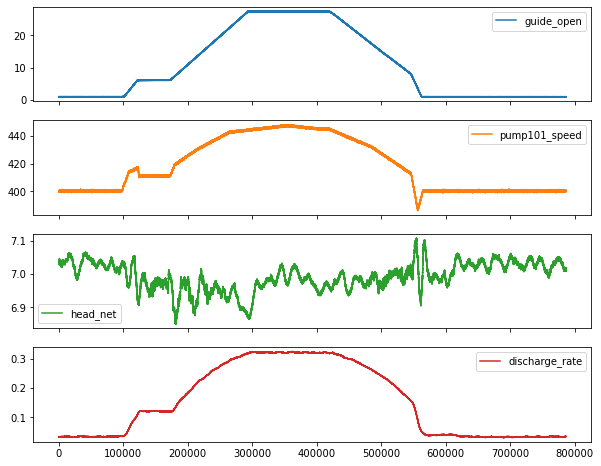
Lets take a close look at the time series.
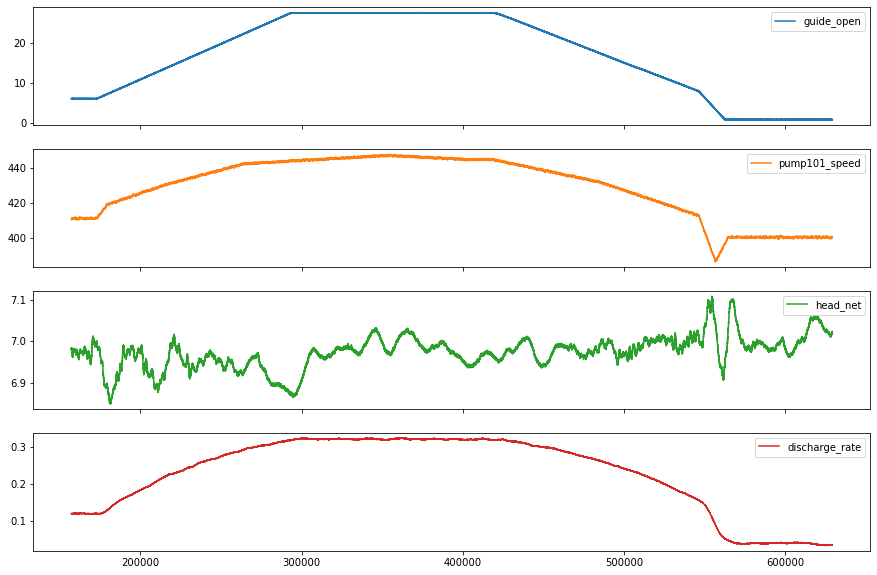
2, Preprocessing data: normalize, train, validation, test, etc.¶
2.1, resample the data with low-resolution¶
df_train = df[feature_keys[[0, 1, 2, 3]+[6]+[5]]][int(len(df)*0.2):int(len(df)*0.8):10]
display(Markdown('<span style="color:red; font-size:30px">**No. of the values in the training dataset is: %d**</span>' %len(df_train)))
# plot the data and check their variations along time
df_train.plot(subplots=True, figsize=(15, 10))
plt.show()
#print('No. of the values in the training dataset is: %d' %len(df_train))
display(Markdown('<span style="color:blue; font-size:20px">**Plot the heatmap for variation of standard deviation**</span>'))
# check he correlation
import seaborn as sns
plt.figure(figsize=(12, 6))
sns.heatmap(df_train.corr(), annot=True, fmt=".2f")
plt.show()
No. of the values in the training dataset is: 47186

Plot the heatmap for variation of standard deviation
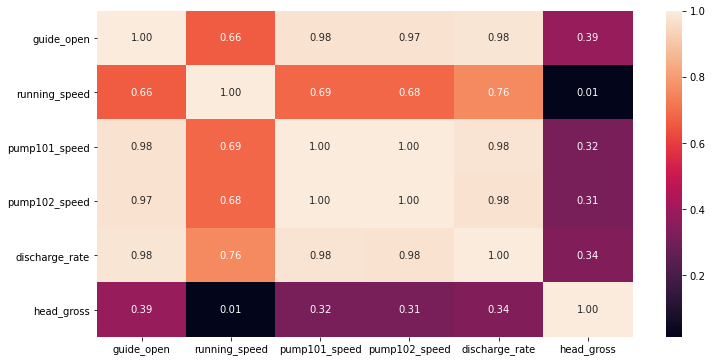
2.2, normalize the data¶
# First, we assume all data are used for the training (the time series is not that stationary for the prediction)
df_train_mean = df_train.mean()
df_train_std = df_train.std()
train_df = (df_train-df_train_mean) / df_train_std
fig2 = train_df.plot(subplots=True,figsize=(15,10))
# Second, plot the standand deviation of features within this dataframe
df_std = train_df.melt(var_name='Column', value_name='Normalized')
plt.figure(figsize=(12, 6))
ax = sns.violinplot(x='Column', y='Normalized', data=df_std)
fig3 = ax.set_xticklabels(train_df.keys(), rotation=90)
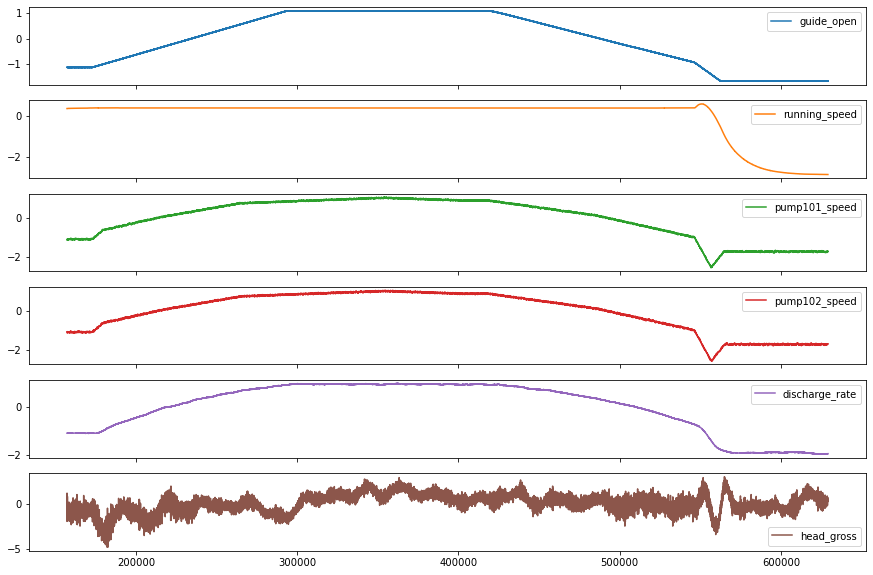

3, Analysis: step = 1; past =100; future = 10 (2021-11-05)¶
df_train = df_train.reset_index(drop=True)
split_fraction = 0.8
train_split = int(df_train.shape[0]*split_fraction)
past = 100
future = 10
step = 1
learning_rate = 0.01
batch_size = 50
epochs = 10
train_data = df_train.loc[0:train_split-1]
val_data = df_train.loc[train_split:]
# Prepare training dataset
start = past + future
end = start + train_split
x_train = train_data.values
y_train = df_train.iloc[start:end]['head_gross'].values
y_train = y_train[:, np.newaxis]
sequence_length = int(past/step)
dataset_train = tf.keras.preprocessing.timeseries_dataset_from_array(
x_train,
y_train,
sequence_length = sequence_length,
sampling_rate=step,
batch_size = batch_size,
)
# Prepare validation dataset
x_end = len(val_data) - past - future
label_start = train_split + past + future
x_val = val_data.iloc[:x_end].values
y_val = val_data.loc[label_start:]['head_gross'].values
y_val = y_val[:, np.newaxis]
dataset_val = tf.keras.preprocessing.timeseries_dataset_from_array(
x_val,
y_val,
sequence_length = sequence_length,
sampling_rate=step,
batch_size = batch_size,
)
# Print the dimension of the inputs and targets
for batch in dataset_train.take(1):
inputs, targets = batch
print(inputs.numpy().shape)
print(targets.numpy().shape)
(50, 100, 6)
(50, 1)
# Construct the model
from tensorflow import keras
inputs = keras.layers.Input(shape=(inputs.shape[1], inputs.shape[2]))
lstm_out = keras.layers.LSTM(32)(inputs)
outputs = keras.layers.Dense(1)(lstm_out)
model = keras.Model(inputs=inputs, outputs=outputs)
model.compile(optimizer=keras.optimizers.Adam(learning_rate=learning_rate), loss="mse")
model.summary()
Model: "model"
_________________________________________________________________
Layer (type) Output Shape Param #
=================================================================
input_1 (InputLayer) [(None, 100, 6)] 0
_________________________________________________________________
lstm (LSTM) (None, 32) 4992
_________________________________________________________________
dense (Dense) (None, 1) 33
=================================================================
Total params: 5,025
Trainable params: 5,025
Non-trainable params: 0
_________________________________________________________________
# Estimate the LSTM model
path_checkpoint = "model_checkpoint.h5"
es_callback = keras.callbacks.EarlyStopping(monitor="val_loss", min_delta=0, patience=5)
modelckpt_callback = keras.callbacks.ModelCheckpoint(
monitor="val_loss",
filepath=path_checkpoint,
verbose=1,
save_weights_only=True,
save_best_only=True,
)
history = model.fit(
dataset_train,
epochs=epochs,
validation_data=dataset_val,
callbacks=[es_callback, modelckpt_callback],
)
Epoch 1/10
753/753 [==============================] - 8s 7ms/step - loss: 3.1805 - val_loss: 1.3407
Epoch 00001: val_loss improved from inf to 1.34072, saving model to model_checkpoint.h5
Epoch 2/10
753/753 [==============================] - 5s 7ms/step - loss: 0.0012 - val_loss: 1.3457
Epoch 00002: val_loss did not improve from 1.34072
Epoch 3/10
753/753 [==============================] - 5s 7ms/step - loss: 0.0013 - val_loss: 1.3575
Epoch 00003: val_loss did not improve from 1.34072
Epoch 4/10
753/753 [==============================] - 5s 7ms/step - loss: 0.0013 - val_loss: 1.3697
Epoch 00004: val_loss did not improve from 1.34072
Epoch 5/10
753/753 [==============================] - 5s 7ms/step - loss: 0.0012 - val_loss: 1.3746
Epoch 00005: val_loss did not improve from 1.34072
Epoch 6/10
753/753 [==============================] - 5s 7ms/step - loss: 9.9973e-04 - val_loss: 1.3843
Epoch 00006: val_loss did not improve from 1.34072
! nvcc --version
! /opt/bin/nvidia-smi
nvcc: NVIDIA (R) Cuda compiler driver
Copyright (c) 2005-2021 NVIDIA Corporation
Built on Sun_Aug_15_21:18:57_Pacific_Daylight_Time_2021
Cuda compilation tools, release 11.4, V11.4.120
Build cuda_11.4.r11.4/compiler.30300941_0
The system cannot find the path specified.
# Visualize the results
def visualize_loss(history, title):
loss = history.history["loss"]
val_loss = history.history["val_loss"]
epochs = range(len(loss))
plt.figure()
plt.plot(epochs, loss, "b", label="Training loss")
plt.plot(epochs, val_loss, "r", label="Validation loss")
plt.title(title)
plt.xlabel("Epochs")
plt.ylabel("Loss")
plt.legend()
plt.show()
visualize_loss(history, "Training and Validation Loss")

# Prediciton
def show_plot(plot_data, delta, title):
labels = ["History", "True Future", "Model Prediction"]
marker = [".-", "rx", "go"]
time_steps = list(range(-(plot_data[0].shape[0]), 0))
if delta:
future = delta
else:
future = 0
plt.title(title)
for i, val in enumerate(plot_data):
if i:
plt.plot(future, plot_data[i], marker[i], markersize=10, label=labels[i])
else:
plt.plot(time_steps, plot_data[i].flatten(), marker[i], label=labels[i])
plt.legend()
plt.xlim([time_steps[0], (future + 5) * 2])
plt.xlabel("Time-Step")
plt.show()
return
for x, y in dataset_val.take(5):
show_plot(
[x[0][:, 5].numpy(), y[0].numpy(), model.predict(x)[0]],
12,
"Single Step Prediction",
)
print(f"The actual value is: {y[0].numpy()}, while the predicted value is: {model.predict(x)[0]}")
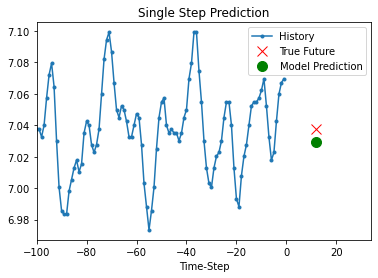
The actual value is: [7.03749], while the predicted value is: [7.029217]
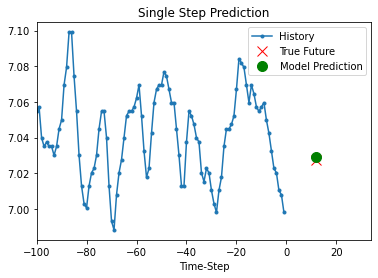
The actual value is: [7.0276425], while the predicted value is: [7.029217]

The actual value is: [7.049805], while the predicted value is: [7.029217]

The actual value is: [7.06212], while the predicted value is: [7.029217]
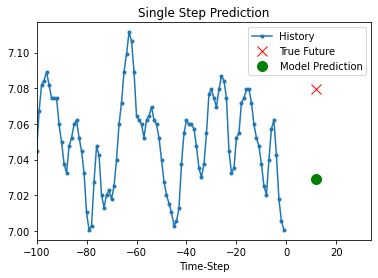
The actual value is: [7.0793625], while the predicted value is: [7.029217]
4, Analysis: step = 10; past =1000; future = 10 (2021-11-06)¶
df_train = df_train.reset_index(drop=True)
split_fraction = 0.8
train_split = int(df_train.shape[0]*split_fraction)
past = 1000
future = 10
step = 10
learning_rate = 0.01
batch_size = 50
epochs = 10
train_data = df_train.loc[0:train_split-1]
val_data = df_train.loc[train_split:]
# Prepare training dataset
start = past + future
end = start + train_split
x_train = train_data.values
y_train = df_train.iloc[start:end]['head_gross'].values
y_train = y_train[:, np.newaxis]
sequence_length = int(past/step)
dataset_train = tf.keras.preprocessing.timeseries_dataset_from_array(
x_train,
y_train,
sequence_length = sequence_length,
sampling_rate=step,
batch_size = batch_size,
)
# Prepare validation dataset
x_end = len(val_data) - past - future
label_start = train_split + past + future
x_val = val_data.iloc[:x_end].values
y_val = val_data.loc[label_start:]['head_gross'].values
y_val = y_val[:, np.newaxis]
dataset_val = tf.keras.preprocessing.timeseries_dataset_from_array(
x_val,
y_val,
sequence_length = sequence_length,
sampling_rate=step,
batch_size = batch_size,
)
# Print the dimension of the inputs and targets
for batch in dataset_train.take(1):
inputs, targets = batch
print(inputs.numpy().shape)
print(targets.numpy().shape)
## Construct the model
# Construct the model
from tensorflow import keras
inputs = keras.layers.Input(shape=(inputs.shape[1], inputs.shape[2]))
lstm_out = keras.layers.LSTM(32)(inputs)
outputs = keras.layers.Dense(1)(lstm_out)
model = keras.Model(inputs=inputs, outputs=outputs)
model.compile(optimizer=keras.optimizers.Adam(learning_rate=learning_rate), loss="mse")
model.summary()
# Estimate the LSTM model
path_checkpoint = "model_checkpoint.h5"
es_callback = keras.callbacks.EarlyStopping(monitor="val_loss", min_delta=0, patience=5)
modelckpt_callback = keras.callbacks.ModelCheckpoint(
monitor="val_loss",
filepath=path_checkpoint,
verbose=1,
save_weights_only=True,
save_best_only=True,
)
history = model.fit(
dataset_train,
epochs=epochs,
validation_data=dataset_val,
callbacks=[es_callback, modelckpt_callback],
)
# Visualize the results
def visualize_loss(history, title):
loss = history.history["loss"]
val_loss = history.history["val_loss"]
epochs = range(len(loss))
plt.figure()
plt.plot(epochs, loss, "b", label="Training loss")
plt.plot(epochs, val_loss, "r", label="Validation loss")
plt.title(title)
plt.xlabel("Epochs")
plt.ylabel("Loss")
plt.legend()
plt.show()
visualize_loss(history, "Training and Validation Loss")
(50, 100, 6)
(50, 1)
Model: "model_1"
_________________________________________________________________
Layer (type) Output Shape Param #
=================================================================
input_2 (InputLayer) [(None, 100, 6)] 0
_________________________________________________________________
lstm_1 (LSTM) (None, 32) 4992
_________________________________________________________________
dense_1 (Dense) (None, 1) 33
=================================================================
Total params: 5,025
Trainable params: 5,025
Non-trainable params: 0
_________________________________________________________________
Epoch 1/10
735/735 [==============================] - 6s 7ms/step - loss: 1.6749 - val_loss: 5.9166
Epoch 00001: val_loss improved from inf to 5.91663, saving model to model_checkpoint.h5
Epoch 2/10
735/735 [==============================] - 5s 7ms/step - loss: 0.0013 - val_loss: 5.9464
Epoch 00002: val_loss did not improve from 5.91663
Epoch 3/10
735/735 [==============================] - 5s 7ms/step - loss: 0.0012 - val_loss: 5.9565
Epoch 00003: val_loss did not improve from 5.91663
Epoch 4/10
735/735 [==============================] - 5s 7ms/step - loss: 9.9394e-04 - val_loss: 5.9735
Epoch 00004: val_loss did not improve from 5.91663
Epoch 5/10
735/735 [==============================] - 5s 7ms/step - loss: 8.0812e-04 - val_loss: 5.9885
Epoch 00005: val_loss did not improve from 5.91663
Epoch 6/10
735/735 [==============================] - 5s 7ms/step - loss: 6.3145e-04 - val_loss: 5.9819
Epoch 00006: val_loss did not improve from 5.91663
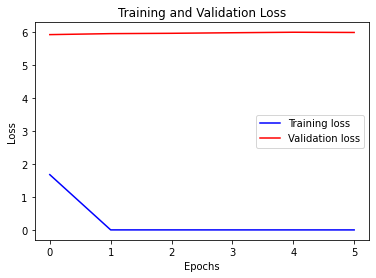
for x, y in dataset_val.take(2):
show_plot(
[x[0][:, 5].numpy(), y[0].numpy(), model.predict(x)[0]],
12,
"Single Step Prediction",
)

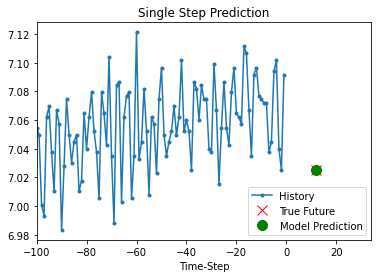
5, Analysis: step = 10; past =100; future = 10 (2021-11-06)¶
df_train = df_train.reset_index(drop=True)
split_fraction = 0.8
train_split = int(df_train.shape[0]*split_fraction)
past = 100
future = 10
step = 10
learning_rate = 0.01
batch_size = 50
epochs = 10
train_data = df_train.loc[0:train_split-1]
val_data = df_train.loc[train_split:]
# Prepare training dataset
start = past + future
end = start + train_split
x_train = train_data.values
y_train = df_train.iloc[start:end]['head_gross'].values
y_train = y_train[:, np.newaxis]
sequence_length = int(past/step)
dataset_train = tf.keras.preprocessing.timeseries_dataset_from_array(
x_train,
y_train,
sequence_length = sequence_length,
sampling_rate=step,
batch_size = batch_size,
)
# Prepare validation dataset
x_end = len(val_data) - past - future
label_start = train_split + past + future
x_val = val_data.iloc[:x_end].values
y_val = val_data.loc[label_start:]['head_gross'].values
y_val = y_val[:, np.newaxis]
dataset_val = tf.keras.preprocessing.timeseries_dataset_from_array(
x_val,
y_val,
sequence_length = sequence_length,
sampling_rate=step,
batch_size = batch_size,
)
# Print the dimension of the inputs and targets
for batch in dataset_train.take(1):
inputs, targets = batch
print(inputs.numpy().shape)
print(targets.numpy().shape)
## Construct the model
# Construct the model
from tensorflow import keras
inputs = keras.layers.Input(shape=(inputs.shape[1], inputs.shape[2]))
lstm_out = keras.layers.LSTM(32)(inputs)
outputs = keras.layers.Dense(1)(lstm_out)
model = keras.Model(inputs=inputs, outputs=outputs)
model.compile(optimizer=keras.optimizers.Adam(learning_rate=learning_rate), loss="mse")
model.summary()
# Estimate the LSTM model
path_checkpoint = "model_checkpoint.h5"
es_callback = keras.callbacks.EarlyStopping(monitor="val_loss", min_delta=0, patience=5)
modelckpt_callback = keras.callbacks.ModelCheckpoint(
monitor="val_loss",
filepath=path_checkpoint,
verbose=1,
save_weights_only=True,
save_best_only=True,
)
history = model.fit(
dataset_train,
epochs=epochs,
validation_data=dataset_val,
callbacks=[es_callback, modelckpt_callback],
)
# Visualize the results
def visualize_loss(history, title):
loss = history.history["loss"]
val_loss = history.history["val_loss"]
epochs = range(len(loss))
plt.figure()
plt.plot(epochs, loss, "b", label="Training loss")
plt.plot(epochs, val_loss, "r", label="Validation loss")
plt.title(title)
plt.xlabel("Epochs")
plt.ylabel("Loss")
plt.legend()
plt.show()
visualize_loss(history, "Training and Validation Loss")
(50, 10, 6)
(50, 1)
Model: "model_2"
_________________________________________________________________
Layer (type) Output Shape Param #
=================================================================
input_3 (InputLayer) [(None, 10, 6)] 0
_________________________________________________________________
lstm_2 (LSTM) (None, 32) 4992
_________________________________________________________________
dense_2 (Dense) (None, 1) 33
=================================================================
Total params: 5,025
Trainable params: 5,025
Non-trainable params: 0
_________________________________________________________________
Epoch 1/10
753/753 [==============================] - 5s 5ms/step - loss: 2.5029 - val_loss: 0.4215
Epoch 00001: val_loss improved from inf to 0.42147, saving model to model_checkpoint.h5
Epoch 2/10
753/753 [==============================] - 3s 5ms/step - loss: 0.0012 - val_loss: 0.4271
Epoch 00002: val_loss did not improve from 0.42147
Epoch 3/10
753/753 [==============================] - 3s 4ms/step - loss: 0.0013 - val_loss: 0.4371
Epoch 00003: val_loss did not improve from 0.42147
Epoch 4/10
753/753 [==============================] - 3s 4ms/step - loss: 0.0013 - val_loss: 0.4426
Epoch 00004: val_loss did not improve from 0.42147
Epoch 5/10
753/753 [==============================] - 4s 5ms/step - loss: 0.0011 - val_loss: 0.4474
Epoch 00005: val_loss did not improve from 0.42147
Epoch 6/10
753/753 [==============================] - 3s 5ms/step - loss: 8.8771e-04 - val_loss: 0.4551
Epoch 00006: val_loss did not improve from 0.42147
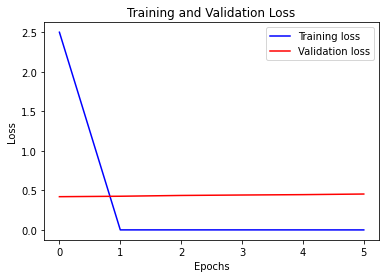
for x, y in dataset_val.take(2):
show_plot(
[x[0][:, 5].numpy(), y[0].numpy(), model.predict(x)[0]],
12,
"Single Step Prediction",
)
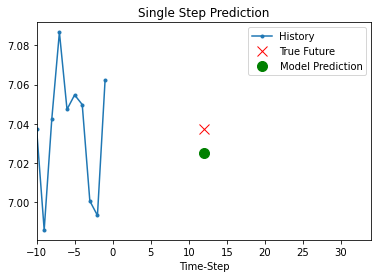
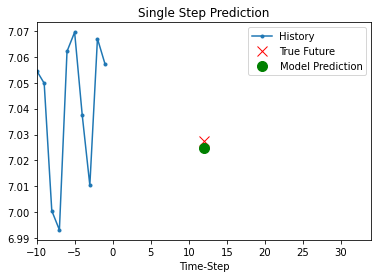
6, Analysis: step = 1; past =1000; future = 10 (2021-11-06)¶
df_train = df_train.reset_index(drop=True)
split_fraction = 0.8
train_split = int(df_train.shape[0]*split_fraction)
past = 1000
future = 10
step = 1
learning_rate = 0.01
batch_size = 50
epochs = 10
train_data = df_train.loc[0:train_split-1]
val_data = df_train.loc[train_split:]
# Prepare training dataset
start = past + future
end = start + train_split
x_train = train_data.values
y_train = df_train.iloc[start:end]['head_gross'].values
y_train = y_train[:, np.newaxis]
sequence_length = int(past/step)
dataset_train = tf.keras.preprocessing.timeseries_dataset_from_array(
x_train,
y_train,
sequence_length = sequence_length,
sampling_rate=step,
batch_size = batch_size,
)
# Prepare validation dataset
x_end = len(val_data) - past - future
label_start = train_split + past + future
x_val = val_data.iloc[:x_end].values
y_val = val_data.loc[label_start:]['head_gross'].values
y_val = y_val[:, np.newaxis]
dataset_val = tf.keras.preprocessing.timeseries_dataset_from_array(
x_val,
y_val,
sequence_length = sequence_length,
sampling_rate=step,
batch_size = batch_size,
)
# Print the dimension of the inputs and targets
for batch in dataset_train.take(1):
inputs, targets = batch
print(inputs.numpy().shape)
print(targets.numpy().shape)
## Construct the model
# Construct the model
from tensorflow import keras
inputs = keras.layers.Input(shape=(inputs.shape[1], inputs.shape[2]))
lstm_out = keras.layers.LSTM(32)(inputs)
outputs = keras.layers.Dense(1)(lstm_out)
model = keras.Model(inputs=inputs, outputs=outputs)
model.compile(optimizer=keras.optimizers.Adam(learning_rate=learning_rate), loss="mse")
model.summary()
# Estimate the LSTM model
path_checkpoint = "model_checkpoint.h5"
es_callback = keras.callbacks.EarlyStopping(monitor="val_loss", min_delta=0, patience=5)
modelckpt_callback = keras.callbacks.ModelCheckpoint(
monitor="val_loss",
filepath=path_checkpoint,
verbose=1,
save_weights_only=True,
save_best_only=True,
)
history = model.fit(
dataset_train,
epochs=epochs,
validation_data=dataset_val,
callbacks=[es_callback, modelckpt_callback],
)
# Visualize the results
def visualize_loss(history, title):
loss = history.history["loss"]
val_loss = history.history["val_loss"]
epochs = range(len(loss))
plt.figure()
plt.plot(epochs, loss, "b", label="Training loss")
plt.plot(epochs, val_loss, "r", label="Validation loss")
plt.title(title)
plt.xlabel("Epochs")
plt.ylabel("Loss")
plt.legend()
plt.show()
visualize_loss(history, "Training and Validation Loss")
(50, 1000, 6)
(50, 1)
Model: "model_3"
_________________________________________________________________
Layer (type) Output Shape Param #
=================================================================
input_4 (InputLayer) [(None, 1000, 6)] 0
_________________________________________________________________
lstm_3 (LSTM) (None, 32) 4992
_________________________________________________________________
dense_3 (Dense) (None, 1) 33
=================================================================
Total params: 5,025
Trainable params: 5,025
Non-trainable params: 0
_________________________________________________________________
Epoch 1/10
735/735 [==============================] - 26s 34ms/step - loss: 1.7236 - val_loss: 3.6228
Epoch 00001: val_loss improved from inf to 3.62276, saving model to model_checkpoint.h5
Epoch 2/10
735/735 [==============================] - 24s 33ms/step - loss: 0.0013 - val_loss: 3.6557
Epoch 00002: val_loss did not improve from 3.62276
Epoch 3/10
735/735 [==============================] - 24s 33ms/step - loss: 0.0013 - val_loss: 3.6720
Epoch 00003: val_loss did not improve from 3.62276
Epoch 4/10
735/735 [==============================] - 24s 33ms/step - loss: 0.0011 - val_loss: 3.6864
Epoch 00004: val_loss did not improve from 3.62276
Epoch 5/10
735/735 [==============================] - 24s 33ms/step - loss: 8.8305e-04 - val_loss: 3.7074
Epoch 00005: val_loss did not improve from 3.62276
Epoch 6/10
735/735 [==============================] - 24s 33ms/step - loss: 7.0599e-04 - val_loss: 3.7107
Epoch 00006: val_loss did not improve from 3.62276
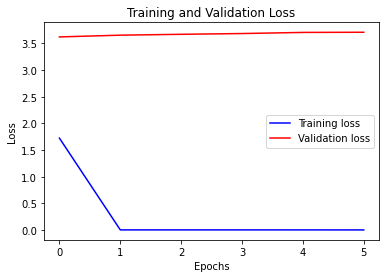
for x, y in dataset_train.take(2):
show_plot(
[x[0][:, 5].numpy(), y[0].numpy(), model.predict(x)[0]],
12,
"Single Step Prediction",
)
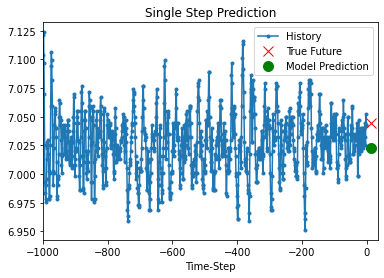
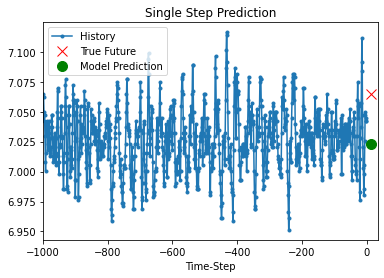
7, Here we will try to resample the data with \(interval =10\) and set step =1¶
df_train = df_train.reset_index(drop=True)
# Change the time interval
df_train_resample = df_train[0:len(df_train):10].reset_index(drop=True)
split_fraction = 0.8
train_split = int(df_train_resample.shape[0]*split_fraction)
past = 20
future = 1
step = 1
learning_rate = 0.01
batch_size = 50
epochs = 10
train_data = df_train_resample.loc[0:train_split-1]
val_data = df_train_resample.loc[train_split:]
# Prepare training dataset
start = past + future
end = start + train_split
x_train = train_data.values
y_train = df_train.iloc[start:end]['head_gross'].values
y_train = y_train[:, np.newaxis]
sequence_length = int(past/step)
dataset_train = tf.keras.preprocessing.timeseries_dataset_from_array(
x_train,
y_train,
sequence_length = sequence_length,
sampling_rate=step,
batch_size = batch_size,
)
# Prepare validation dataset
x_end = len(val_data) - past - future
label_start = train_split + past + future
x_val = val_data.iloc[:x_end].values
y_val = val_data.loc[label_start:]['head_gross'].values
y_val = y_val[:, np.newaxis]
dataset_val = tf.keras.preprocessing.timeseries_dataset_from_array(
x_val,
y_val,
sequence_length = sequence_length,
sampling_rate=step,
batch_size = batch_size,
)
# Print the dimension of the inputs and targets
for batch in dataset_train.take(1):
inputs, targets = batch
print(inputs.numpy().shape)
print(targets.numpy().shape)
## Construct the model
# Construct the model
from tensorflow import keras
inputs = keras.layers.Input(shape=(inputs.shape[1], inputs.shape[2]))
lstm_out = keras.layers.LSTM(32)(inputs)
outputs = keras.layers.Dense(1)(lstm_out)
model = keras.Model(inputs=inputs, outputs=outputs)
model.compile(optimizer=keras.optimizers.Adam(learning_rate=learning_rate), loss="mse")
model.summary()
# Estimate the LSTM model
path_checkpoint = "model_checkpoint.h5"
es_callback = keras.callbacks.EarlyStopping(monitor="val_loss", min_delta=0, patience=5)
modelckpt_callback = keras.callbacks.ModelCheckpoint(
monitor="val_loss",
filepath=path_checkpoint,
verbose=1,
save_weights_only=True,
save_best_only=True,
)
history = model.fit(
dataset_train,
epochs=epochs,
validation_data=dataset_val,
callbacks=[es_callback, modelckpt_callback],
)
# Visualize the results
def visualize_loss(history, title):
loss = history.history["loss"]
val_loss = history.history["val_loss"]
epochs = range(len(loss))
plt.figure()
plt.plot(epochs, loss, "b", label="Training loss")
plt.plot(epochs, val_loss, "r", label="Validation loss")
plt.title(title)
plt.xlabel("Epochs")
plt.ylabel("Loss")
plt.legend()
plt.show()
# plot the modelling history results
visualize_loss(history, "Training and Validation Loss")
# plot the prediction results
for x, y in dataset_val.take(2):
show_plot(
[x[0][:, 5].numpy(), y[0].numpy(), model.predict(x)[0]],
future,
"Single Step Prediction",
)
(50, 20, 6)
(50, 1)
Model: "model_4"
_________________________________________________________________
Layer (type) Output Shape Param #
=================================================================
input_5 (InputLayer) [(None, 20, 6)] 0
_________________________________________________________________
lstm_4 (LSTM) (None, 32) 4992
_________________________________________________________________
dense_4 (Dense) (None, 1) 33
=================================================================
Total params: 5,025
Trainable params: 5,025
Non-trainable params: 0
_________________________________________________________________
Epoch 1/10
76/76 [==============================] - 2s 9ms/step - loss: 21.8318 - val_loss: 16.7973
Epoch 00001: val_loss improved from inf to 16.79725, saving model to model_checkpoint.h5
Epoch 2/10
76/76 [==============================] - 0s 6ms/step - loss: 1.1807 - val_loss: 9.7418
Epoch 00002: val_loss improved from 16.79725 to 9.74181, saving model to model_checkpoint.h5
Epoch 3/10
76/76 [==============================] - 0s 6ms/step - loss: 0.0142 - val_loss: 9.0928
Epoch 00003: val_loss improved from 9.74181 to 9.09284, saving model to model_checkpoint.h5
Epoch 4/10
76/76 [==============================] - 0s 6ms/step - loss: 0.0028 - val_loss: 9.0786
Epoch 00004: val_loss improved from 9.09284 to 9.07864, saving model to model_checkpoint.h5
Epoch 5/10
76/76 [==============================] - 0s 6ms/step - loss: 0.0028 - val_loss: 9.0819
Epoch 00005: val_loss did not improve from 9.07864
Epoch 6/10
76/76 [==============================] - 0s 6ms/step - loss: 0.0029 - val_loss: 9.0841
Epoch 00006: val_loss did not improve from 9.07864
Epoch 7/10
76/76 [==============================] - 0s 6ms/step - loss: 0.0029 - val_loss: 9.0855
Epoch 00007: val_loss did not improve from 9.07864
Epoch 8/10
76/76 [==============================] - 0s 6ms/step - loss: 0.0030 - val_loss: 9.0861
Epoch 00008: val_loss did not improve from 9.07864
Epoch 9/10
76/76 [==============================] - 0s 6ms/step - loss: 0.0030 - val_loss: 9.0858
Epoch 00009: val_loss did not improve from 9.07864

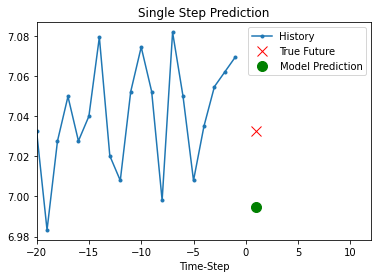
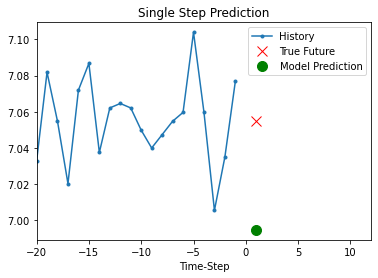
2, Complete procedure to run Keras model¶
# 1, read the data
# 2, organize the data
# 3, prepare the model
# 4, run the ML
# 5, check the results
